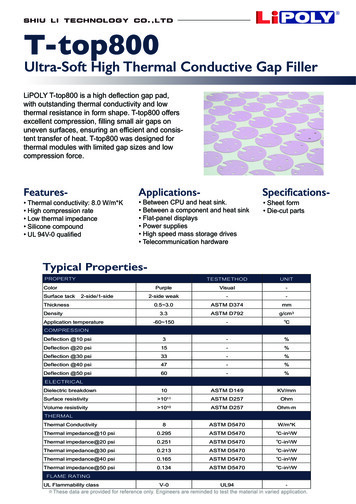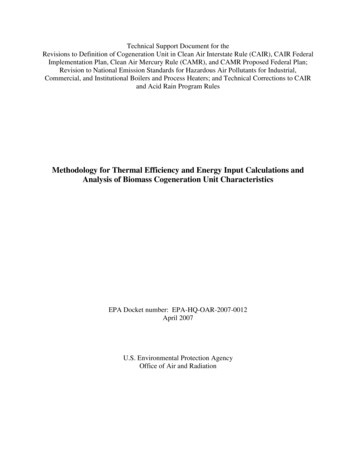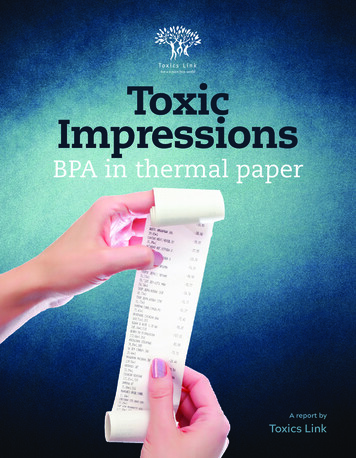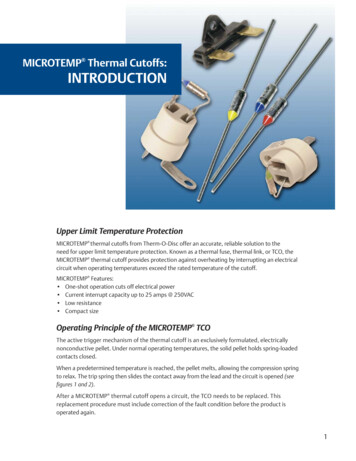
Transcription
Active Thermal Control System for CubeSatPradeep Shinde, Anthony Fernandez, Ibrahim Tansel, Sabri TosunogluDepartment of Mechanical and Materials EngineeringFlorida International University10555 West Flagler StreetMiami, Florida 33174pshin001@fiu.edu, afern401@fiu.edu, tanseli@fiu.edu, tosun@fiu.eduABSTRACTThe use of CubeSat systems for low-orbit data collection hasincreased due to their low cost development and light weightdesigns. For efficient data collection to occur, it is imperative thatthe satellite’s internal components remain fully functionalthroughout its mission life. To ensure the components remain intheir operational range, an internal thermal control subsystem mustbe developed to effectively combat the transfer of heat. Thestandard size and payload of a CubeSat eliminates the possibility ofdesigning a conventional fluid flow piping system. Through thedevelopment of a phase change material (PCM) thermal controlsystem, the internal components will experience smallertemperature variations, while remaining within their operationallimits. The melting temperature for optimal PCM performance,with a component operational range from 0-40 , is currentlydesired to be 45 , and the selection between Organic and Inorganicmaterials can be found below. The calculations developed in thisreport assume that the outside radiation and ultraviolet heat sourceswill minimally impact the temperature of the interior structure,allowing for further focus on the component heat generation. Thispaper presents preliminary designs and calculations towards thedevelopment of a low cost and replicable active thermal controlsystem for the interior of CubeSats and is originally intended forimplementation on Florida International Universities’ NEESAT.KeywordsHeat transfer, Conduction, Radiation, Phase change material(PCM), Thermal control system, CubeSat, 3U, FUNSat, NEESatNOMENCLATUREThermal Energy, WThermal Conductivity,Cross-Sectional Area,Section Length, mDDiameter, mHot Temperature, CCold Temperature, CρDensity, 1. INTRODUCTIONThe increase in popularity of CubeSat systems has allowed for largescale research towards the development of low cost, low weight andeffective in-orbit data collection. The Florida InternationalUniversity’s Near Earth Explorer Club is currently manufacturinga 3U picosatellite for use in the NASA FUNSat competition, withthe goal of further developing existing CubeSat research. Tominimize the systems payload while remaining in the satellite’sinternal boundaries (10 x 10 x 30 cm), the overall weight and sizeof the thermal control system must be minimized. To achieve thisgoal, the current system design integrates the use of a PCM toprovide the necessary thermal control to allow the multiple internalcomponents (seen in 3.1 – Components) to operate efficientlythroughout the intended twenty-year mission life.A PCM, or phase change material, is a description given to anysubstance that has a sharp melting point and a large heat of fusion[1]. This combination of properties allows PCMs to have vastapplications in the thermal control of space equipment and vehicles.Through the use of chemical bonds, PCMs are able to store andrelease large amounts of latent heat energy while consistentlyhaving a low temperature difference [1]. The latent heat storagemethod developed through PCMs has 5-14 times more heatcapacity per unit volume when compared to materials used insensible heat storage systems, further increasing their effectiveusage in a CubeSat cooling subsystem. The most common andeffective PCM transformation is the solid-liquid because of thesmall volume change necessary for implementation, whencompared to vaporization and sublimation [2]. Due to thecomplexity of the design, the large volume changes that occurduring the vaporization and sublimation phase transition rules outtheir potential utility in a thermal storage system [3].A PCM material needs a high latent heat of fusion per unit mass tobe able to store a large amount of latent heat energy in a smallvolume of material. A high thermal conductivity is necessary toincrease the temperature gradient required for charging the storagematerial so the material could absorb large quantities of heat in ashort period of time. With a large density value, a smaller volumeof material will provide an ease for encapsulation method designs,while maintaining proper absorption and rejection parameters. Toensure a stable system life, the phase change material must haveminimal chemical decomposition, as well as an increased thermalstability [1]. PCMs are categorized into three main material groups:30th Florida Conference on Recent Advances in Robotics, May 11-12, 2017, Florida Atlantic University, Boca Raton, Florida
organics, inorganics and eutectic (combination or organic andinorganic materials), as seen in Figure 1 – ‘Classification of PCMs’below.Table 1 – List of Components per System [4]SubsystemOpticalAttitudeDeterminationand ControlCommunicationFigure 1 – Classification of PCMs [3]2. THERMAL CONTROL SYSTEM FORINTERNAL HEAT GENERATIONThe thermal control system serves the main function of maintainingthe internal components within their operational temperaturesthroughout the proposed mission life. The NEESat system iscomposed of multiple heat generating subsystems, each with theirown components, as follows: optical, attitude determination andcontrol, communication and computing, as seen in 3.1 –Components, below. A major challenge in the development of thePCM thermal control system lies in the configuration of theseparate subsystem components within the overall CubeSatstructure. Multiple phases of thermal calculations were performedto gather a fundamental understanding of the effects of parametervariations within the preliminary design. An example of a PCMthermal control system can be seen in Figure 2 – PCM ‘ThermalControl System for Short-Duty-Cycle Electronic Components’,below.Figure 2 - PCM Thermal-Control System for Short-Duty-CycleElectronic Components [2]In this thermal control system, the PCM is component dependent,meaning that each component requires its own thermal controlsystem. A CubeSat system containing many heat generatinginternal components would not benefit from such a system due tothe strict payload and space parameters. A design containing acentralized PCM thermal control system would have the greatestadvantage for a CubeSat system because it will centralize the heatand transfer it equally throughout the system.2.1 ComponentsAs previously mentioned, the proposed components for the NEESatare separated into the following subsystems: optical, attitudedetermination and control, communication and computing, with amore detailed list shown in Table 1 – ‘NEESat Components perSubsystem’, below.ComputingCMOSOV14810 CMOSSeekThermalTMP36 (x10)IR Temp Sensor (x6)LSM9DS0Max PowerReq. (W)0.380.640.280.000.080.04Sun Sensor (x6)1.5USRP GPS AntennaPower AmplifierArduino MegaBeagleBone Black (x2)3.07.05.022.0139.93ComponentTotalFor the mission of the NEESat system to be fully achievable, thethermal control system must be designed to combat the maximumpower output achievable by the internal components. Thecomponents require the temperature to be maintained between 040 because of the lower operational temperature range of theonboard lithium polymer batteries, as seen in Table 2 – ‘InternalComponent Operating Temperatures.’Table 2 – Internal Component Operating Temperatures [4]InternalComponentsCMOSOV14810 CMOSSeekThermalTMP36IR Temp SensorArduino MegaBeagleBone BlackLithium PolymerBatteryOperating Temperatures [ ]-40-30-30-40-40-40-40 85 70 70 125 125 85 900 45An example of some of the components used in the optical systemcan be seen in Figure 3 – ‘Sensor Components used in OpticalSubsystem’ below. The sizes of the individual components andcomputing chips vary, but each poses a challenge for the design ofa centralized heat exchange system.Figure 3 – Sensor Components used in Optical Subsystem [4]The NEESat system is composed of multiple subsystems, each withits own set of components, example seen in Figure 3 above andFigure 4 below. Figure 3 shows an example of the SeekThermaland CMOS chips, both located in the optical system. Figure 4,below, shows an example of the LSM9DS0 sensor which is used in30th Florida Conference on Recent Advances in Robotics, May 11-12, 2017, Florida Atlantic University, Boca Raton, Florida
the attitude and orbital control system, developed by a previous FIUFUNSAT team, to orient the CubeSat towards the sun [5].With the use of Equation (2), the PCM temperature for each of thecomponents, with the parameters detailed above, were determinedand noted in Table 4 – ‘Determined PCM Temperature perComponent’.Table 4. Determined PCM Temperature per ComponentFigure 4 – LSM9DS0 Sensor used in Attitude and Orbital Control [5]For the development of preliminary thermal calculations, theoverall power consumption for each NEESat subsystem wasdetermined through past experiences, as well as literature research,and is populated in Table 1, above. The overall component powerconsumption of 40 Watts will be used to aid in the determinationof the various centralized PCM parameters, as seen in section 3.2 –Thermal Calculations.2.2 Thermal CalculationsThe preliminary calculations developed in the following phasesections were determined using the heat transfer equations andfixed parameters, shown below. The development of the thermalcontrol system required that the maximum power consumption ofthe electronic components be equal to the maximum heat generated,as seen in Table 4 below. Designing in terms of the worst possiblescenario will ensure that the components will remain in theiroperational range. The first equation (1), as seen below, was usedto determine the average conduction temperature of the PCM in thecentralized heat pipe system design with the following fixedparameters:Table 3. Fixed Parameters in Phase 1ParameterValueThermal Conductivity [k]401Cross-Sectional Area [A]0.053Heat Pipe Length [L]1Component Temperature [ ]35DeterminedPCMTemperature[ ]CMOS0.3833.22OV14810 CMOS0.6431.95SeekThermal0.2833.67IR Temp Sensor0.0834.61LSM9DS00.0434.83Sun Sensor1.5027.89USRP GPS Antenna3.0020.77Power Amplifier7.001.81Arduino Mega5.0011.29BeagleBone Black22.01-69.372.2.1 Phase 1 – Average Temperature of PCMThe first phase of calculations will determine the averagetemperature of the centralized PCM encasement by utilizing thecomponent data provided in Table 4, as well as the fixed parametersdetailed in Table 3. With the total heat output being 40 Watts, itwas determined that the average temperature of the PCM with allthe components generating heat is 16.07 .2.2.2 Phase 2 – Heat Pipe Length VariationsUnits The three components with the largest heat generation wereselected to determine the thermal effect when changing the heatpipe length. The parameters selected for the second phase ofpreliminary calculations can be found in Table 5 below. cmTable 5. Fixed Parameters in Phase 2The thermal conductivity value of 401 stated above istaken from the copper heat pipe material, while the heat pipe lengthwas fixed for preliminary calculations. The cross sectional areavalue was determined from the diameter value of 2.59 mm in 10gauge copper wire. The temperature of the component was set to35 because of the maximum operational temperature of 40 forthe internal components. ComponentTotal HeatOutput[W](1)(2)Equation (1) was then manipulated to determine the temperature atthe end of the heat pipe secured to the central PCM encasement, asseen in Equation (2) above.ParameterValueThermal Conductivity [k]401Cross-Sectional Area [A]0.053Heat Pipe Length [L]2Component Temperature [ ]35Units cmThe effect of doubling the heat pipe length for the BeagleBoneBlack, power amplifier and Arduino Mega can be found in Table 6below.Table 6. Length Variation Effect on Component TemperatureComponentTotal HeatOutput [W]Determined PCMTemperature [ ]Arduino Mega5.00-12.42Power Amplifier7.00-31.39BeagleBone Black22.01-173.7530th Florida Conference on Recent Advances in Robotics, May 11-12, 2017, Florida Atlantic University, Boca Raton, Florida
As seen in Table 6, it was determined that doubling the length ofthe heat pipe resulted in a lower average temperature for the centralPCM system. To be able to properly design a centralized PCMthermal control system, the final design will have varying heat pipelengths for each component, which will be determined in a futurecalculation phase.2.3 PCM SelectionTo effectively combat the 40 Watt heat output of the internalcomponents, it was determined that a material with a 45 phasechange temperature is effective at regulating the large temperaturevariations. The PCM types being considered for use in the NEESatinternal thermal control subsystem are Organic and Inorganic, asseen in Figure 1 above. The NEESat internal thermal controlresearch conducted will focus on organic PCMs due to theirenvironmental and financial benefits, but will also includeinorganics because of their high heat of fusion and availability [3].PCMs contain many important physical and chemical propertiesthat allow them to be useful and efficient in thermal energy storageenvironments. A PCM requires a high latent heat of fusion per unitmass to be able to store large amounts of latent heat energy in asmall amount of material [1]. A high thermal conductivity isnecessary to increase the temperature gradient required forcharging the material to a phase change temperature to aid in thecapturing of latent heat [1]. With a larger density value, a smallvolume of material will reduce necessary space requirements forthe method of centralized PCM encapsulation. In comparison toinorganics, organic materials have a moderate thermal energystorage density, which requires a larger surface area to combat theeffect of the lower conductivity. . Besides having a melting point inthe desired temperature parameters for the application, a PCMshould be non-poisonous, non-flammable and non-explosive tominimize the health and safety requirements needed to develop andoperate such a system, as well as minimizing the ecological andenvironmental impacts of its production and use. To ensure a stablesystem life, the phase change material must have minimal chemicaldecomposition, as well as an increased thermal stability [1].Research was conducted to determine commercially available andcost effective PCM materials 45 melting, or phase change,temperature. The organic and inorganic PCMs proposed forpossible use in the NEESat internal thermal cooling subsystem canbe found in Tables 7 – ‘Organic PCMs Proposed for NEESatApplication’ and 8 – ‘Inorganic PCMs Proposed for NEESatApplication’ seen on the following page.Table 8. Inorganic PCMs Proposed for NEESat ApplicationMaterialPhase ChangeTemperature[ ]Density[ Latent HeatCapacity[ ]S44**441584100S46**461587210** Material and technical information gathered from PCM Products.Tables 7 and 8 show a direct comparison between the latent heatcapacities of organic and inorganic PCMs. Although the latent heatper mass values vary by 100 , the value that contributes tothe large thermal capacity of inorganic PCMs is the density. Thelower material densities of organic materials will require a largervolume, which could be inhibited by the NEESat internal spaceparameters.Although extremely beneficial to space and component limitedthermal energy storage systems, PCMs experience degradationssuch as phase segregation and super cooling. Organic phase changematerials constantly operate in a melting and freezing cycle withoutany phase segregation, or congruent melting, they crystallize withlittle super cooling and they usually share non-corrosive properties[3]. Salt hydrate inorganic PCMs succumb to the problem of phaseseparation and super cooling, which decreases the temperature atwhich the material solidifies. [6]. When salt hydrates are melted,multiple other hydrates form. These newly developed hydratessettle out over time and reduce the overall volume available for thestorage of latent heat [6]. With the addition of multiple differentchemicals and materials to PCMs, such as conductive particles intoorganic paraffins or nucleating agents in inorganic salt hydrates,these problems could be effectively countered [6].2.4 Proposed DesignThe thermal control system for the internal heat generatingcomponents of the NEESat will consist of a centralized PCM heatexchange design. The proposed PCM thermal energy storage (TES)design will thermoregulate the electrical components by directconduction through a heat pipe alternative, as seen in Figure 5 –‘Central PCM TES System’ below. In this thermal energy storagesystem, the energy lost from the electronic components during itshot atmospheric orbit is transferred directly into the central PCM,through heat pipes, with the indirect intention of heating the systemduring its cold atmospheric orbit [2].Table 7. Organic PCMs Proposed for NEESat ApplicationMaterialPhase ChangeTemperature[ ]Density[ Latent HeatCapacity[ ]PureTemp 42*PureTemp 810218230165242155234* Material and technical information gathered from Entropy Solutions,LLC** Material and technical information gathered from PCM Products.Figure 5 – Central PCM TES System [2]The proposed system design will be composed of PCMencapsulated in a metallic, chemically compatible, container with adirect and secure connection to one end of the heat pipe. The otherend of the heat pipe will be securely fastened to the surface of theelectrical component, to ensure that connections remain fixedthrough the vibrations experienced during the CubeSat’s journey to30th Florida Conference on Recent Advances in Robotics, May 11-12, 2017, Florida Atlantic University, Boca Raton, Florida
orbit. The heat pipe will be developed through use of commerciallyavailable copper wire, as seen in Figure 6 – ‘NEESat ProposedCopper Wire Heat Pipe’ below, with the final gauge size to bedetermined for each component through further simulation andtesting. Copper was chosen as the heat transfer medium due to itshigh thermal conductivity of 401 , its low cost andcommercial availability.Figure 6 – NEESat Proposed Copper Wire Heat PipeThrough a series of precise solders, the heat pipe could be securelyfastened to the proposed encapsulation sphere of the PCM. Onechallenge of thermal regulation in space is the limitation toconductive methods of heating and cooling, which increases thedifficulty of securing the remaining end of the heat pipe to thecomponents surface. A component friendly method of securing theheat pipe to its respective surface will ensure efficient operationthroughout the systems desired mission life.report outlines the research, calculations and analysis performedtowards the development of an interior cooling system for the FIUNEESat, which will be competing in the 2016-2017 NASA FUNSatcompetition. The active thermal control system offers payload andspace advantages while thermoregulating the 40 Watts ofmaximum component heat generated into the system.The proposed subsystem was designed using the parameters on theexisting NEESat structure, the FUNSat competition standards, theCubeSat standards, as well as the multiple parameters listed insection 3.2. Along with the finalization of the proposed thermalcontrol system design, the individual components must besimulated and tested for their conductive heat generation as well asthe determination of the PCM thermal regulating rates.5. ACKNOWLEDGMENTSThe preliminary phase calculations seen in section 3.2, above, usethe average temperature value of the PCM to determine the averageheat pipe length for the system. It is important to note that this phaseof calculations does not reflect the heat pipe length of eachindividual component in the system.The development of the NEESat system is being performed as partof the 2016-2017 FUNSAT competition, which is organized byNASA’s Florida Space Grant Consortium (FSGC). The FSGCprovided the financial funding necessary for the NEESat subsystemresearch to be conducted, as well as the project motivation andcompetition parameters. The authors also acknowledge the supportreceived from Florida International University’s (FIU) Departmentof Mechanical and Materials Engineering (MME), as well as thereviewers for their comments. The authors would also like toextended their thanks to the members of FIU’s Near Earth Explorer(NEE) student chapter for the continuation of aerospace researchtowards competition success and the future development of anaerospace academic program.3. DISCUSSION6. REFERENCESThis paper presents an active thermal control system for the internalregulation of CubeSat systems, with specific implementation on theFIU NEESat. The proposed design incorporates a centralized phasechange material encasement, previously discussed in section 3.4,which will thermoregulate the 40 Watts of internal heat generatedby the components through a series of conductive heat pipes.Section 3.2 details the preliminary phase thermal calculationsconducted to begin the determination of the final PCM as well asthe parameters necessary to design an efficient system. The PCMsaverage temperature through the hot atmospheric orbit wasdetermined to be 16.07 with the initial parameters set in section3.2.1. The initial heat pipe length of 1.0 cm was varied in section3.2.2 to determine the relationship between temperature variationswith the length values. It was determined that doubling the heatpipe length from 1.0 to 2.0 cm resulted in a large decrease in thePCMs average temperature. Further research, analysis anddevelopment will be conducted towards the final design of thecentralized PCM internal thermal control system through use oftwo simulation software, SolidWorks and ANSYS, as well aslaboratory vacuum chamber testing at FIU’s Advanced MaterialsEngineering Research Institute (AMERI).4. CONCLUSIONThe proposed internal thermal control subsystem design offers acost effective, commercially available and easily adaptable methodof thermoregulating a wide range of CubeSat applications. This[1] A., Sekar, Siddhartha Jain D.N., Govinda K.V., and ArunKumar S. "Phase Change Materials (PCM) for ThermalControl During Spacecraft Transportation." InternationalJournal of Mechanical and Industrial Engineering 3.1 (2013):1-5. Web.[2] Bledjian, L., M.J. Hoover, and M.J. O'Neill. "Phase-ChangeMaterials." (n.d.): 373-403. Web.[3] Rathod, Manish K, and Jyotirmay Banerjee. “ThermalStability of Phase Change Materials Used in Latent HeatEnergy Storage Systems: A Review, “Renewable andSustainable Energy Reviews” 18 (2013): 246-58. Web.[4] Hernandez, Sergio, Walter Salas, Cruz Philippe, ElijahNewman, Paul Frosik, and Jonathan De Groot. RoarSAT.Thesis. Florida International University, 2016. N.p.: n.p., n.d.Print.[5] Shinde Pradeep, Newman Elijah, Tansel Ibrahim, TosunogluSabri. Design of FIU FUNSAT System: Attitude Control forthe 3U CubeSat. FCRAR 2016.[6] Lane GA. Solar heat storage: latent heat material, vol. 1,Background and scientific principles. Florida: CRC Press;1983.30th Florida Conference on Recent Advances in Robotics, May 11-12, 2017, Florida Atlantic University, Boca Raton, Florida
30th Florida Conference on Recent Advances in Robotics, May 11-12, 2017, Florida Atlantic University, Boca Raton, Florida organics, inorganics and eutectic (combination or organic and inorganic materials), as seen in Figure 1 - ' Classification of PCMs ' below. Figure 1 - Classification of PCMs [3] 2. THERMAL CONTROL SYSTEM FOR











